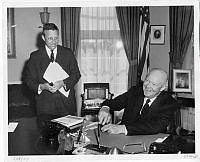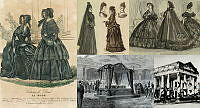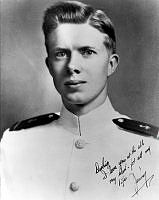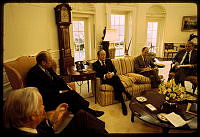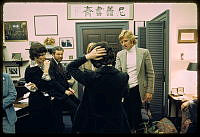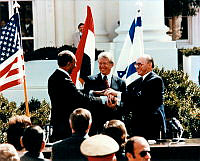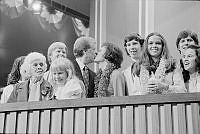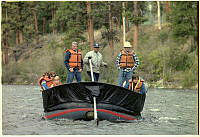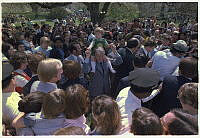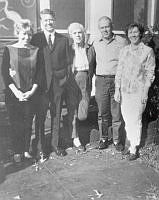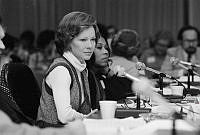
Rubenstein Center Scholarship
The Life and Presidency of Herbert Hoover
The 2016 White House Christmas Ornament Historical Essay
The 2016 White House Christmas ornament honors the administration of the thirty-first president of the United States Herbert Hoover, who served from 1929 to 1933. The ornament is inspired by the fire engines that responded to the 1929 Christmas Eve fire at the White House and the toy trucks presented to children by the Hoovers the following Christmas. Crafted from shiny brass plated with nickel and 24k gold, the engine carries a decorated Christmas tree for delivery to the White House.
Prologue: A Fire in the West Wing
The White House was filled with Christmas cheer when the traditional festivities got underway on the evening of December 24, 1929. Wreaths hung in the windows and holly adorned the rooms. President and Mrs. Herbert Hoover were entertaining his staff and their children at a Christmas party while the Marine Band played carols in the Entrance Hall. All seemed well, but a snowfall the day before had brought a bitter cold to the city of Washington, and on that night, the White House would suffer its most devastating fire since 1814, when flames delivered by British torches gutted the mansion, leaving nothing but its exterior stone walls.
The drama began when Chief Usher Ike Hoover whispered urgently in the president’s ear: “The executive office is on fire!” President Hoover rose from the dinner table and asked the men to follow him into the hall and onto the scene of the fire in the West Wing. Built in 1902, the wing contained the president’s offices, including the first Oval Office, which was added in 1909. Hoover’s son Allan joined the men, who proceeded to rescue as many of the president’s papers as time allowed, while First Lady Lou Hoover, informed about the blaze, calmly remained to supervise the party. The Marine Band played on.

Firefighters battle the blaze in the West Wing executive offices, December 24, 1929.
Library of CongressThe four-alarm fire brought nineteen engine companies and four truck companies to the White House. One hundred and thirty firefighters began to battle the blaze by breaking a domed skylight, hacking holes in the roof to release the smoke, and dragging the fire hoses in.
President Hoover, clad in a heavy blue overcoat and black hat, took a position on top of the adjacent West Terrace to watch the firemen do their work. Some of the hoses froze, becoming geysers of ice. Puffing a cigar and rubbing his hands for warmth, the president occasionally moved to dodge the powerful back and forth of the water hoses. By about 10:30 p.m., the fire was extinguished.
The next morning, the president and several cabinet members returned, sloshing through deep standing water, to assess the damage. Fire Chief George Watson reported that excessive heat from a blocked chimney flue or defective electric wiring had caused
pamphlets stored in the attic to ignite, and fire had spread quickly. Although the exterior walls of the West Wing survived, the roof, attic, and floors were either burned or warped beyond repair. Congress would soon pass a special appropriation to rebuild the uninsured office wing. The Charles H. Tompkins Company of Washington, D.C., completed the work and Hoover and his aides moved back into the remodeled West Wing on April 14, 1930.

Thirty-First President Herbert Hoover
White House Historical Association (White House Collection)Herbert Clark Hoover (1874–1964)
The first president from west of the Mississippi, Herbert Clark Hoover was born in the Quaker community of West Branch, Iowa, on August 10, 1874. His father Jesse, a blacksmith, died when Herbert was six. When his mother Huldah, a minister in the Society of Friends, died four years later, young Herbert was taken in by Henry John Minthorn, his maternal uncle in Newburg, Oregon. His brother and sister were sent to live with other relatives. A shy and conscientious young man, he enrolled at Leland Stanford University in Palo Alto, California, in 1891—the university’s inaugural year. He blossomed there and fell in love with fellow geology student Lou Henry. They married in 1899.
Following his graduation in 1895, Hoover traveled throughout the world as a mining engineer and became an expert in mining finance and management. From 1907 to 1912, Herbert and Lou Hoover completed the first English translation from Latin of the classic sixteenth-century mining book De Re Metallica. Their scholarly annotations provided the most comprehensive history of mining to that date. As an international mining expert and financier, Hoover made a personal fortune and turned then to achieve his ambition to make a contribution to the world.
In the early days of World War I, the first opportunity arose for Hoover to launch a career in public service when he coordinated efforts to lend money to Americans stranded in London. Soon, as head of the Commission for Relief in Belgium, he became universally known as the “Great Humanitarian.” When the United States entered the war, President Woodrow Wilson appointed Hoover to run the U.S. Food Administration, which was charged with efficiently and economically increasing food production and distribution on the home front. A superb organizer and administrator, Hoover was so highly regarded that in February 1921 newly elected President Warren G. Harding invited him to join his cabinet as secretary of commerce. He accepted the offer.
Hoover, the most dynamic member of the Harding–Coolidge cabinets, often made the news; one Washington wit described him as “the secretary of commerce and the undersecretary of everything else.” He was a technocrat who loved innovation. A determined Hoover expanded the department’s reach beyond business promotion and into product research, safety standards, housing and home ownership, business ethics, labor disputes and policy, radio, aviation, and U.S. commercial expansion overseas. When the Mississippi overflowed its banks in the spring of 1927, Hoover organized federal relief efforts in partnership with the Red Cross and local communities.

President Herbert Hoover and First Lady Lou Hoover in 1929.
Library of CongressThe Herbert Hoover Presidential Administration (1929–33)
Once President Coolidge announced his August 1927 decision not to seek reelection, a network of Hoover supporters went into action to launch a campaign and efficiently lined up convention delegates. Old Guard Republicans joined the bandwagon, if grudgingly. The conservative wing of the party resented the fact that Hoover’s public career had begun under the Wilson administration and was aghast at his support for the League of Nations, collective bargaining rights, and federal regulation of portions of the economy. Chief Justice Taft considered him a “dreamer” and fretted: “The truth is that Hoover is a progressive.”
Accepting the nomination the day after his 54th birthday, Hoover observed that, “given a chance to go forward with the policies of the last eight years, we shall soon with the help of God be in sight of the day when poverty will be banished from this Nation”—words that would later be used against him. His campaign circulated a copper Hoover Lucky Pocket Piece engraved with the words “Good for four more years of prosperity.” The Democratic nominee, New York governor Alfred E. Smith, struggled in vain to make headway against the voters’ wish to ratify the Coolidge prosperity and obtain more. On Election Day Hoover carried forty states and won by 6.4 million votes. “I have no fears for the future of our country . . . It is bright with hope,” he said in his inaugural address.
In his early months in office, Hoover sought to move beyond the relative inactivity of the Harding–Coolidge years. His administration promoted water resource development, child health and protection, and improved education and health care for Native Americans. He increased funding for the National Park Service and federal penal reform, and supported establishment of an expanded National Institutes of Health, a Federal Farm Board to encourage agricultural cooperatives, and the Boulder Canyon project, which would give birth to Hoover Dam. In foreign affairs, he favored disarmament and improved relations with Latin America.

First Lady Lou Henry Hoover in 1928.
Stock Montage, Harris and Ewing CollectionLou Henry Hoover
As the official White House hostess, Lou Hoover welcomed visitors with poise and dignity. She was a thoroughly “modern woman” for her time. Independent and self sufficient, she brought to her White House role a well-traveled perspective gained from years of adventure accompanying Herbert Hoover to isolated mining areas around the world. As first lady, she was not afraid of controversy, and overruled the White House tradition of racial segregation by inviting to tea Jessie DePriest, the wife of Republican Oscar Stanton DePriest, the first African-American member of Congress since 1901.
Lou Hoover appreciated the significance of the White House as a historic place and introduced a display of historical paintings, portraits, and objects in the Entrance Hall where visitors gathered before tours. The first lady also initiated a study to catalog all of the historic objects in the White House. As a tribute to President James Monroe, she created the Monroe Room (today’s Treaty Room) on the Second Floor where Monroe had kept his office, furnishing it with reproductions of several pieces of Monroe’s own furniture.
Influenced by long years of social experience around the world—notably in England—the Hoovers entertained with style. Their after dinner roster of prominent artists who performed in the White House included Grace Moore, Rosa Ponselle, Jascha Heifetz, Vladimir Horowitz, and many others. On April 29, 1931, harpist Mildred Dilling played for King Phra Pok Klao Prajadhipok of Siam. The Hoovers also enjoyed the performances of the Hampton and Tuskegee choirs, the first black choirs to return to the White House since the Fisk Jubilee Singers of Nashville sang for President Arthur.
Times Change: The Crash of 1929 and After
Less than a year into Hoover’s administration, the Great Depression overwhelmed the nation. Like dominoes, one section of the economy collapsed onto another, contributing to an unprecedented disaster. Banks failed in the “panic” of depositors to withdraw their accounts. Drought ravaged farmlands turned to dust. Personal income, investments, and manufacturing plummeted while unemployment, farm foreclosures, and municipal and state debt soared. Soup kitchens, breadlines, and “Hoovervilles”—threadbare camps built by the homeless and unemployed—became all-too-familiar sights. In Texas, armadillos were called “Hoover hogs.” If not universal, the Depression reached deeper into the American culture than any economic crisis before or since.
A firm believer in volunteerism and community generosity in time of need, Hoover struggled to stop the Panic (which the event was called before “Depression” took its place) through citizen participation. The emotional storm that came with the Panic was, to him, an obstacle to recovery. He pleaded with businesses to sacrifice profits before cutting jobs, asked industry to keep wages high so people could afford to buy consumer goods, and urged banks and loan companies to aggressively search for investment opportunities. He created the Reconstruction Finance Corporation to furnish loans to banks, corporations, and state governments for housing and public works projects.
Political conflict had never appealed to Hoover, and his preference for working alone meant he usually relied more on administrative action than on politics and vital public persuasion, to accomplish his goals. Aware of his often aloof personality, he rejected suggestions to make regular visits to areas with high unemployment, saying, “This is not a showman’s job, I will not step out of character and you can’t make a Teddy Roosevelt out of me.”
By 1932 Hoover faced long odds for reelection. In much of the public’s mind, the humanitarian and awe-inspiring expert they knew in 1928 had become a heartless automaton unable to halt the nation’s widespread suffering. The Democratic nominee, Governor Franklin D. Roosevelt of New York, exuded a buoyant, jaunty air that contrasted favorably with Hoover’s dour public image. In lackluster speeches, Hoover appealed for upholding economic traditions, tried to defend his record, and voiced concern about what Roosevelt might do if elected. At home in Palo Alto, as the scope of the crushing defeat became clear, Hoover conceded the election, thus becoming the sixth incumbent to be denied a second term.
Christmas at the Hoover White House
President and Mrs. Hoover welcomed their children and grandchildren to the White House over the holidays each year. Their younger son Allan usually came home from Harvard Law School. Herbert Hoover Jr. and his wife Margaret brightened the White House scene with their children Peggy Ann, Joan, and Herbert “Pete” Hoover III. First Lady Lou Hoover often spent Christmas Eve distributing food baskets at the Salvation Army and attending such events as the disabled veterans’ Christmas sale at Walter Reed Hospital in 1929.

Workers collect fire-damaged debris from the Oval Office, December 26, 1929.
Library of CongressFew White House Christmases were more dramatic than 1929, the year of the West Wing fire. At dusk from 1930 to 1932 on Christmas Eve, President Hoover touched the button that lit the National Community Christmas Tree in various locations on and around the White House grounds. Afterward, the Hoovers hosted a party for children of the staff members.
In 1931, during the depth of the Depression, Hoover scaled down the cost of Christmas festivities and donated the savings to charities. After conceding defeat in the election of 1932, the Hoovers spent the holidays on a cruise in the coastal waters of Georgia and Florida. They did not return to attend the non-invitational New Year’s Day reception at the White House, ending forever a public holiday tradition started in 1801 and long beloved, especially by diplomats, government officials, and military officers. The event was in its decline anyway—crowds had swelled to more than 6,000 by the 1930s. Logistics and security made the open house too arduous to continue. Hoover, as it was, took the leap.
After the White House
The Hoovers elected to live between California and New York City. Mrs. Hoover’s sudden death in 1944—twelve years after they left the White House—fairly well settled the former president in one place, New York City, where he lived at the Waldorf-Astoria Hotel. During the 1930s, Hoover, a fine writer, wrote books and articles and delivered speeches disapproving of the New Deal, worked to expand the Hoover Institution at Stanford University, and devoted himself to charities and organizations such as the Boys’ Clubs. Following World War II, at President Truman’s invitation, he traveled to Europe and Latin America to coordinate famine relief, as effectively as he had done thirty years before. He also chaired the advisory Hoover Commission to increase government efficiency. By the time he died in 1964 at age 90, Hoover’s long record of public service confirmed his reputation as a great humanitarian.















